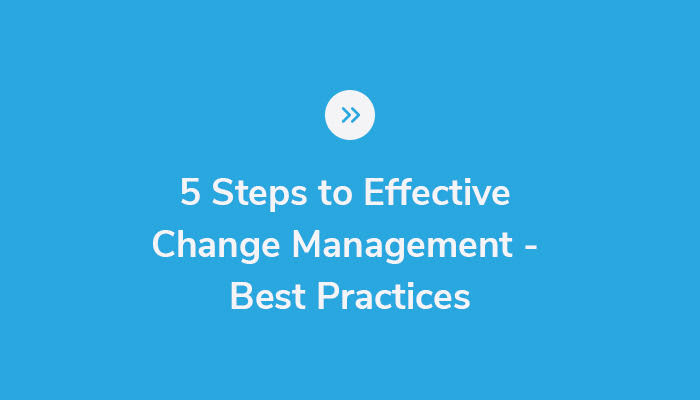Change Management Best Practices: 5 Steps to Effective Implementation

Transforming your business to be customer-centric is hard. This is not a surprise to any executive who has attempted large-scale organizational change that spans people, process and technology. Customer data platforms (CDPs) have emerged as the technology best suited to accelerate transformation efforts that enable brands to deliver personalized customer experiences at scale. But technology is not enough. In order to realize the full value of your CDP investment, you must have a robust change management plan in place before you start.
According to a recent McKinsey study, nearly 50% of all digital transformation initiatives fail to reach their expected value, and only 10% exceed expectations. In another industry survey, organization leaders identified lack of skilled staff and training as two of the top reasons for not getting the most out of their marketing technology investments.
Nearly 50% of all digital transformation initiatives fail to reach their expected value, and only 10% exceed expectations. – McKinsey
ActionIQ is a technology company, but our mission is bigger than software. We are committed to helping our clients put in place the foundational capabilities to create fulfilling relationships with their customers over the long-term. For that reason, and in response to market demand, we’ve built a practice dedicated to go beyond technology to provide brands with guidance on the people and processes necessary to support successful CDP implementations.
The aim of this article is to help you:
- Align your organization around your CDP goals and outcomes
- Define critical tasks and skills required to onboard and scale a CDP
- Map how a CDP fits into your organization today and in the future
- Identify and mitigate the most significant CDP-related organizational risks
- Learn how ActionIQ can help with CDP change management
Align Your CDP Goals and Outcomes for Effective Change Management
Often, digital transformation initiatives begin with a focus on the solution—or the “how.” But at the outset of a successful transformation, “why” matters much more than “how.” CDP goals and outcomes will be different for every organization. And, depending on the size and complexity of the organization, the goals may be different across teams within the same company. Before designing a solution, you must have alignment around the most important problems and strategic goals your CDP initiative will address. Only then can you progress to defining the solution. Which is why it is critical to start at the end, with the goals and outcomes you hope to achieve with a change management initiative.
1. Create a Strong Business Case
We are all resistant to change. It takes the promise of overwhelming value—along with the sponsorship and communication of your executives—to help break people out of their comfort zones. So, at the outset of your CDP initiative, you must build and socialize a strong business case with convincing ROI. You only earn the organizational buy-in you need to succeed once all stakeholders understand and embrace the value of a CDP.
2. Set a Vision
Your business case is the justification for your change initiative, but your vision is motivation. After your transformation is complete, how do you envision your company and your brand is perceived? How will your brand promise be delivered differently to your customers? We worked with a client, for instance, who wanted to deliver a customer experience where “anytime a customer has an issue with the brand, we want to reach out to them before they contact us.” Once defined, the vision will become the ultimate destination for your people, processes, and technology roadmap
3. Lay Out Your Roadmap for Effective Change
Achieving an ambitious vision such as the one described above requires a long-term roadmap. But you also need quick wins and quick progress to build and maintain momentum. A McKinsey study on business transformation found successful companies typically sprint out of the gates, turning their initial burst of idea generation into an achievable, rigorous management plan within a few short months. These companies see 28% of fully ramped-up value captured in the first three months, and 74% in the first year. That’s why when ActionIQ works with customers to craft a CDP rollout plan, we design a sequence of short-term goals, each serving a stepping stone to the long-term vision.
4. Define Success
Success can’t be subjective. To establish and maintain credibility, you need to define your success metrics, how you’ll measure them, and how you’ll communicate them throughout the organization. Measurement should include an overarching KPI as the “North Star” for the entire organization to focus on. Many options, such as retention rate, NPS score, and revenue per customer, exist depending on the type of business the company is in. However, it’s also important to establish a link between function-specific KPIs (email engagement, frequency of visits to the store, time on site, etc.) that are leading indicators and help every member of the organization to understand how their specific efforts contribute to the customer experience.
Map Critical Tasks With Jobs to Be Done
With your CDP initiative’s foundation set, it’s time to onboard and scale your CDP across the organization. As we mentioned earlier, brands often identify a lack of skilled staff as the reason they can’t get the most out of their martech investments. As such, the next instinct may be to define new roles and hire to fill them. In our experience, this is an organization-centric approach to a customer-centric problem.
Defining new job titles is an organization-centric approach to a customer-centric problem.
Rather than beginning with job titles, we recommend beginning with an examination of the jobs to be done. This is the critical work that will be required for your organization to transform and operate in a more agile and more customer-centric manner. The jobs to be done for implementing and operationalizing your CDP roughly break down into four functional areas:
- Data Access
- Strategy & Insights
- Planning & Operations
- Data Science
In each of these areas, you’ll want to list critical tasks, map these to skills and define timelines.
The jobs to be done framework should be customized to reflect your needs and current structure. The following table shows common outputs from this exercise:
| Function | Output |
| Data Access |
|
| Strategy & Insights |
|
| Planning & Operations |
|
| Data Science |
|
Evaluate Your Organizational Maturity
At the completion of the jobs mapping exercise, you’ll have identified the people-resource requirements needed to deliver your CDP initiative. Now, you need to map those jobs into your organizational structure. Many organizations will take an all-or-nothing approach at this phase of implementing change—either a radical re-org, or attempting to force fit a new model on an old org structure. The most successful organizations, however, take a measured, phased approach.
Regardless of your current organizational structure, a reorganization is not required before you deploy a CDP and achieve meaningful results. Rather, you can focus the early phases of your initiative on quick wins— such as efficiency and productivity gains—that build momentum for effective change management. With this approach, the success of your CDP will help accelerate your organization’s transformation to becoming a more customer-centric structure over time, and position you to move the needle on even higher value KPIs (more on these in a moment).
The most successful organizations take a measured, phased approach to CDP implementation and adoption.
Let’s look at the three types of org structures based on how your business teams and technology teams are organized.
- Channel-Centric: Both teams and technologies are distributed by channel.
- Journey-Centric: Teams are distributed by journey, for example customer onboarding, but technology is consolidated and centralized.
- Customer-Centric: Both teams and technologies are centralized and shared across the full customer experience.
As you move along the organizational maturity curve from channel-centric, to journey-centric, and finally to customer-centric, your teams will be positioned to extract the maximum value from your CDP. For instance, you’ll progress towards optimizing higher value KPIs: initially focusing on opens & clicks, then moving on to CAC and engagement, and finally moving on to optimizing for LTV and retention. You’ll also have graduated to addressing the highest value use cases that deliver transformational customer and business impact.
Organizational efficiency is an additional benefit of moving to a customer-centric org structure. In the channel-centric org configurations, similar jobs are repeated across channels and teams. As you move towards a customer-centric, centralized org structures, a single resource can more efficiently perform the same work across multiple functions. It’s also easier to cross-train personnel, giving your teams the added agility and flexibility required for successful personalization at scale.
Key CDP Learnings for the Organization
Plans and frameworks are helpful for preparing for transformation, but a CDP fundamentally changes how your organization operates. When your plans hit the real world, you may find that the changes proposed by your initiative can be intimidating for many people. That’s why the areas where the CDP impacts teams and long-standing processes represents the biggest risk to an implementation.
Most digital transformation projects fail due to “unexpected” roadblocks—which is why a successful CDP implementation requires you to prepare for the unexpected. Acknowledging this and preparing for likely challenges is critical to the success of your project in the short and longterm.
The Importance of the Project Manager
Project management is critical to your change management plan. A dedicated project manager serves as the single point of contact for your entire CDP initiative. The project manager keeps everyone and everything moving forward, ensures the project is tracking to success metrics, and owns the reporting of milestones to everyone in the organization from executive sponsors on down.
| Risk | Mitigation Strategy |
| Weak data foundation | Work backwards from your high priority use cases to identify critical data sets, then spend the time and effort to get those ready |
| Maintaining current processes | Don’t constrain yourself to re-engineering current processes, but take a holistic approach to auditing and optimizing all processes that impact customer use cases. |
| Lack of skilled staff | Organizations consistently underestimate support needs, so budget in support from partners to validate talent requirements prior to hiring. |
| Lack of training | Prioritize CDP support and services when evaluating vendors and ask for references from existing clients who look like you. |
| Resistance to change | Transformation must be a top priority for the CEO. Ensure C-level support is highly visible across the organization and team incentives reflect the new priorities. |
| Lack of accountability | Create a governance structure which includes an executive sponsor and cross-functional steering committee, regular updates from working teams, and a project manager who owns progress towards goals and clearing roadblocks. |
| Lack of organizational alignment | Ensure cross-functional representation and incentive structure is in place for all stakeholders to drive alignment and ownership of success. |
While the risks involved with organizational change might seem a bit daunting, doing nothing is the biggest risk of all. Maintaining the status quo will make your outcomes certain—your competitors will surpass you, your employees will be less motivated, innovation will stall, and your customers will leave. To survive in the long-term, you must adapt to new requirements and ways of working. We hope the plans, frameworks, and learnings discussed here will inspire you to take the leap, knowing you have the tools needed to cross the chasm.
Value Mapping: Proven Approach to Successful Change Management When Implementing a CDP
As we’ve discussed, implementing a change management process is always the hardest part of any strategic transformation—but you don’t have to go it alone. We’ve built a consulting practice based on years of partnering with the world’s top brands to go beyond technology to enable CDP-led transformations. We call it Value Mapping.
“ActionIQ’s Value Mapping practice helps you put the people, process, and strategy in place to ensure your CDP initiative is successful.”
-
Tamara Gruzbarg, Value Mapping Practice Leader
The Value Mapping engagement is a two week, expert-led exercise focused on establishing the building blocks for your CDP initiative. Core elements of the program include:
1. Best Practices
Identify the strategic vision for your initiative, the quick wins that can be achieved along the way, and the people, process and technology considerations that will define your success.
2. Business Case Development
Define and document the expected ROI of your CDP initiative, and create a high-level roadmap for implementation and usage.
3. Risk Mitigation
Utilize evaluation and requirements gathering tools to aid you in the upfront vetting of vendors, applying best practices for prioritizing requirements, and building alignment across internal stakeholders.
Coming out of the two-week exercise, ActionIQ delivers a Value Mapping Action Plan, defining and documenting everything you need to confidently kick-off your CDP initiative, including:
- Business vision and priorities
- Current state and constraints
- Future state and solution
- Prioritized use case roadmap
With your building blocks and transformation plans in place, your organization will be poised to get the most value out of your CDP investments, delivering the personalized customer experiences that build lasting loyalty and significantly improve business performance.





